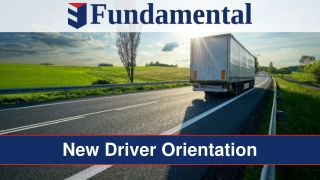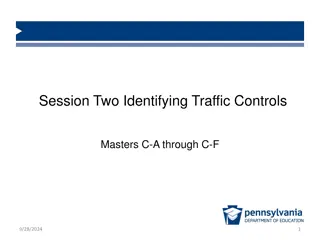Recognizing Warning Signs for High-Risk Drivers at Senior Driver Summit
In the Senior Driver Summit breakout session, Cody Stovall discussed the warning signs of high-risk drivers, emphasizing the importance of clinical driver assessments for older drivers. The program established in 1998 evaluates older drivers with cognitive decline, new drivers needing adaptations, and seasoned drivers requiring modifications. Services include outpatient PT/OT for orthopedic or neurologic conditions. The initiative aims to assess high-risk senior drivers' fitness to drive safely in Tennessee.
Download Presentation

Please find below an Image/Link to download the presentation.
The content on the website is provided AS IS for your information and personal use only. It may not be sold, licensed, or shared on other websites without obtaining consent from the author.If you encounter any issues during the download, it is possible that the publisher has removed the file from their server.
You are allowed to download the files provided on this website for personal or commercial use, subject to the condition that they are used lawfully. All files are the property of their respective owners.
The content on the website is provided AS IS for your information and personal use only. It may not be sold, licensed, or shared on other websites without obtaining consent from the author.
E N D
Presentation Transcript
Recognizing Warning Signs of the High Risk Driver Cody Stovall OTR/L, CDRS Work Plus Rehab Center Jackson, TN Senior Driver Summit Breakout 2016
Son I have been driving longer than you have been alive! I dont know why the doctor sent me here! I have never had a wreck. I m a great driver!
Objectives Provide information about our program Outline the clinical assessment of impaired older drivers and some common observations Describe the purpose of the Safe Roads for Seniors initiative Discuss warning signs and screening tools Outline how you can become involved in Tennessee s senior driver initiative and provide resources
Our program Established in 1998. Perform other services such as outpatient PT/OT services for orthopedic or neurologic conditions Who is evaluated Older drivers with cognitive decline New drivers who might need adaptations Seasoned drivers who have had traumatic events and might need hand controls or other vehicle modifications
What do we do? Clinical driver assessment Vision, short term, long term memory, multi-tasking, rules of the road, road sign recognition, muscle strength/range of motion Behind the wheel Safety during entire 45 min- 1hr drive time Vehicle control What is their speed? Do they blame other drivers or vehicle for their mistakes?
Why are we here? Madison County is #1 for Older Driver crashes in Tennessee The purpose of the current research project Safe Roads for Seniors is to assess high risk senior drivers fitness to drive safely Criteria for driver assessment/ grant funding: Must be referred by physician 65 yrs or older Live in 17 county region of West Tennessee
Why are we here? Educate about options that are in this state Driver Evaluation programs Work Plus Rehab Center Jackson, TN Vanderbilt University Hospital Nashville, TN LifeCare of East Ridge Evaluations are fee for service .Medicare and private insurance do not reimburse Most evaluations are >$500 for this 3-4 hour assessment which is not affordable for most of our clients
Assessment-Vision Visual Acuity must be 20/40 in one eye to be able to drive (State Law) Depth Perception if impaired will have poor stopping distance either in middle of intersection or 10 ft before stop bar for example Road Sign Recognition Sometimes difficulty with simple signs Peripheral Vision poor blind spot checks and usually has dents present on the vehicle
Assessment- Cognition Oriented to Time, Place, Person, Situation For example .Name, Date, Where they are, where they have been or are going Short Term Memory Problem Solving Is Fatigue Noted? Visual Perception How well are their eyes communicating with their brain?
Signs of unsafe driving Determining when someone can no longer safely drive requires careful observation by family and caregivers. The following list provides warning signs that it's time to stop driving: Forgetting how to locate familiar places Failing to observe traffic signs Making slow or poor decisions in traffic Driving at an inappropriate speed Becoming angry or confused while driving Hitting curbs Using poor lane control Making errors at intersections Confusing the brake and gas pedals Returning from a routine drive later than usual Forgetting the destination you are driving to during the trip Read more: http://www.alz.org/care/alzheimers-dementia-and- driving.asp#ixzz4KFy55MQt
Their Vehicle Dents, Scrapes, Different Paint Colors? Can they explain the dents or did they know they were there?
ScreeningDriver Orientation Screen for Cognitive Impairment Driver Orientation Screen for Cognitive Impairment Ask ALL 9 Questions: Subtract one point for each incorrect response. 1. What is your date of birth? Month, day, and year required; must match documents. 2. What is your full home address? Address provided must match document; if not, prompt for address listed on documents. 3. What state are we in now? 4. What city/town are we in now? 5. Without looking at your watch, can you estimate what time it is now? Answer provided must be plus or minus one hour of correct time. 6. What day of the week is it? 7-9. What is today s date? 5 or more incorrect---Priority re-exam Unsafe to drive; refer to department procedures for alternative transportation and vehicle removal 3-4 incorrect---Regular or Priority re-exam Potentially unsafe to drive; consider totality of circumstances 0-2 incorrect---No Referral or Regular re-exam based on totality of circumstances
Predicted Outcomes from SRFS Identify trends and predict the number of senior drivers who will discontinue driving and need alternative transportation Reduce costs because some patients will not meet the criteria for determination of fitness to drive Reduce redundancy of efforts Best Practices will provide statistical support for discontinuing assessments on certain patients with certain diagnosis Information from the research could be helpful in providing useful data to decision makers (insurance companies, policy makers)
What can you do to help? DMV, law enforcement, family members can report a suspected impaired senior driver to the Department of Driver Improvement or family physician/neurologist DMV and Law enforcement staff can receive requested training on identifying potentially at risk drivers Participate in training to become a CarFit technician and/or coordinator to help seniors find the right fit in their cars Work to start a community coalition to support efforts related finding alternative transportation options for seniors Support the Yellow Dot program and ensure that senior drivers get the kit to register for the program
Questions? Cody Stovall OTR/L, CDRS Work Plus Rehab Center 343 Vann Drive, Jackson, TN. 38305 (731) 984-7640 Cody.Stovall@WTH.org Thank you!!























